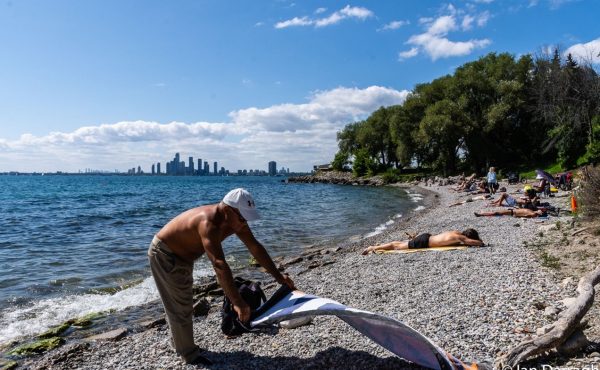
Spacing has Julie Yamin reporting from the two-day Toronto Summit conference.
– – – – – – – – –
You don’t need to live in the heart of Toronto to know the waterfront, the Gardiner, the Island, social service downloading, and transit are just a few of the issues that have befuddled City Hall for years.
But this week, the Toronto Summit 2007, a two-day conference of panel discussions and workshops, gathered professionals and non-profit directors to brainstorm together and bounce new and innovative ideas off each other.
A couple of the eight workshops on Feb. 26 2007 were the Waterfront Revitalization and Beyond the Gas Tax. The summit is oversubscribed, so if you made a game time decision and switched rooms, you were sadly left without a seat at one of the many round tables.
In each workshop, attendees were asked to answer three big questions as a group and then report back. Although broad, the questions allowed for each table to come up with a few ideas and also created some healthy debate, always a good sign during a roundtable discussion.
In the Beyond the Gas Tax room, most people were into the idea of GTA green taxes, a pay-per-use system would greatly help with garbage, water and electricity waste. Another idea was to implement tolls on the city-owned highways. Although many disagreed with placing the tolls with bumper-to-bumper traffic during peak periods as they felt this would both increase the gridlock and increase car emissions.
It was nearly unanimous is all workshops that the city needs to seek help from other levels governments: stop downloading, start uploading and look for more ways to generate revenue without increasing income or property tax. If the issue is tackled properly, Torontonians would warm up to user fees and other funding strategies.
There was also talk of making services cost effective. Toronto needs to make its services and departments accountable from the hours they log to how much they spend on paperclips annually. As Joe Berridge, from Urban Strategies put it, “If you can’t measure it, you can’t manage it.†With the baby boomers slowly heading into retirement, it is Toronto’s chance do a lot of management restructuring.
“If the province wants these services to exist, than the province needs to pay for them,†said Roger Anderson, Regional chair of the Region of Durham during his six-minute speech for Beyong the Gas Tax. He would like to see more independent local government, less band-aid solutions, long-term federal and provincial funding, not short-term help. He says true solutions will be long-term.
Shelley Carroll, Chair of the Budget Committee for Toronto made a really good point early into her speech says that the budget isn’t unbalanced, it’s been balanced every year. It’s the measures needed to make it balanced that is the problem, she says.
Taxes and user fees aside, there were other important discussions yesterday, such as the never-ending saga that is the Waterfront.
Some people might say they are tired of hearing about it, but that wasn’t the case on day one of the summit. People had great ideas for what we could and should be happening on the waterfront.
At the back of the room, members of the media conversed among themselves on the issues brought up in the workshops. Christopher Hume, a Toronto Star columnist said “at some point, people need to be tough. It frustrates me. I haven’t seen it yet.†He doesn’t think anyone is being aggressive enough, “no one mentioned the Gardiner until the end.†He’d like to see the city get their hands dirty and start breaking ground on the hoards of ideas and plans that have come about over the years.
Following the brainstorming, table representatives spoke up about needing to clean out some of the agencies involved with the waterfront. At the moment there are too many people stepping on each others toes down there. They expressed concern about the agency gridlock going on, many of the agencies stepping on each others toes, the removal of some agencies would make life a lot simpler on the waterfront. One of the world’s most well-known urban planners, Ken Greenberg, gave me his top three things that need to change for the waterfront; “one, reduce the number of cars on the street, two, make the transit better and people will use it, and three, take down the Gardiner.â€
Others had more cultural ideas to bring to the plate. One group suggested a cricket field, or a Toronto museum that could also showcase Toronto’s strong first-nations heritage, as well as the city’s past in bootlegging history. Another group thought of creating something similar to the Ottawa skating canal in winter in the Keating Channel. One woman suggested an aquarium. And if was often noted that the city has to plan a waterfront that can be used in all four seasons, not just in the warmer months.
photo by Bouke Salverda




One comment
I just woke up after two days at the summit and I’m left with mixed feelings, including some uncomfortable ones.
The premise of the summit and the work that went into it is commendable. Civil society should play a strong role in developing our short and long terms plans for the city, and we shouldn’t do this only at election time. The City Summit Alliance is a great initiative and I hope they continue with their work.
But the summit had some important weaknesses. The first is in regards to diversity and representation. It’s time to get serious about this. Although some efforts were clearly made to have a diverse audience, and Toronto’s diversity was not represented in the list of keynote addresses made at the summit. Most surprising was the last plenary discussion about “Strong Neighbourhoods”. Rather than have a community leader who actually lives in one of our “13 priority neighbourhoods”, which are disproportionately comprised of people of colour, we listened instead to another white male speaker from Boston who told us about the broken window theory and explained that all we need to do is fix up some buildings and get the drug dealers out. Forget about big investment, forget about looking at the root causes of poverty, forget about the rarely-spoken fact that we’re talking about a racially segregated city which is caused by systemic economic factors that keep the poor, and the rich, in their place. Kick out the drug dealer? Where’s he gonna go? How long will it take to replace him with another? You can’t put a band-aid on a gaping flesh wound.
The second problem was too much involvement of elected politicians. They should be invited of course, and maybe they should even get to talk for a minute or two at the podium, time permitting. But Civil Society can’t get too close to the politicians in power, because you can get co-opted and that’s what much of the summit felt like to me.
Miller used his big speech to launch the “One Cent Now” campaign which would give Toronto 1 cent of the GST, worth about 400 million. This is a tiny amount of what Toronto needs. It’s another band-aid. Perhaps Miller asked for a fraction of what he needs in order to ensure he’ll get it. That’s how politics works. Then Stephane Dion speaks and declines the request for one cent, saying it’s too much to ask for. Of course, party leaders always save their big announcements for election time. Saying no at the summit allows Dion to say yes a few months from now and get headlines during an election and get a pat on the back from Miller, and Miller a pat on the back from all of us.
The whole thing felt like a set-up for future spin. We were all extras on the set of an after-school special called “You Need Ten Apples? Here’s One”. It’s directed by Small Government is Good productions, produced by the PR people in the Miller offices and Dion offices, and consumed by the media who spit it out back to us….
Am I being too cynical? I know I sound cynical, but in the end the numbers just don’t add up to much. The slogan of the conference was “Making Big Things Happen”. But the One Cent campaign won’t allow any big things to happen. It barely covers the operating shortfall we’re already facing. At best, the money just allows the status quo to continue without going into further debt. More importantly, it deflects attention away from the real discussions that needs to happen about shifting public perception of taxes and regaining a sense of the importance and value of collective public investment.
But this is what happens when civil society gets too close to the politicians. The whole thing gets co-opted and becomes part of their spin campaigns.
I hope there are future City Summits. The small workshops were good, the discussions that were sparked are important and the networks that were built are crucial for a strong and engaged public. But I hope the next summit has less politicians at the podium and less imported “experts” at the podium. In their place should be the real experts: Community leaders from every corner of this diverse city.